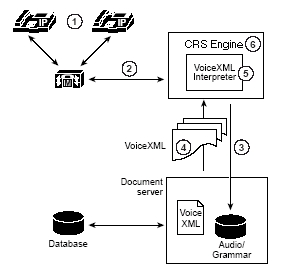Voice Browser Architecture
Voice Browser consists of the following three components:
-
Document server—Processes requests from the VoiceXML interpreter. The server produces VoiceXML documents in reply.
-
VoiceXML Interpreter—Processes the document. The VoiceXML interpreter executes the VoiceXML application, doing prompting and voice recognition via the Cisco Unified CCX Engine. The VoiceXML interpreter processes the input and may then branch or submit information to the document server according to the application logic.
The Voice Browser interprets VoiceXML documents and performs the dialog with the user. The web application model is a client server model. The role of the Voice Browser is that of a web client, fetching documents from a web server.
-
Implementation Platform—Detects and answers incoming calls and responds to other telephony events. It is also responsible for prompting and receiving user input. The VoiceXML interpreter controls the Cisco Unified CCX implementation platform.
Figure shows the architecture for the Voice Browser system. See the steps below the figure for an explanation of the process that the diagram illustrates.

The following is an example of a VoiceXML process flow:
-
The user makes a call to a phone number.
-
The Cisco Unified CCX system answers the call and invokes the VoiceXML interpreter to perform the dialog.
-
The VoiceXML interpreter makes a request “http://abc/HelpDesk.vxml”.
-
The document server receives the request. It processes, formats, and returns the document.
-
The VoiceXML interpreter interprets the document.
-
The interpreter performs prompting and voice recognition through the Cisco Unified CCX Engine.
-
Based on user input, the application continues. For example, it may loop back to Step 3 to make another request with information gathered to the document server.